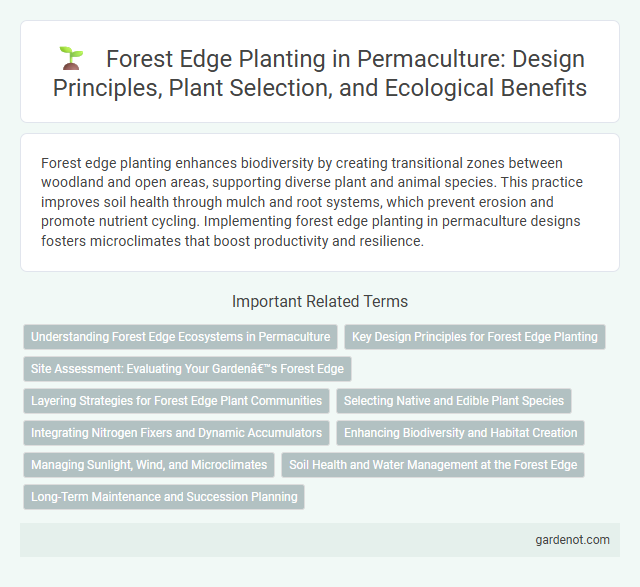Forest edge planting enhances biodiversity by creating transitional zones between woodland and open areas, supporting diverse plant and animal species. This practice improves soil health through mulch and root systems, which prevent erosion and promote nutrient cycling. Implementing forest edge planting in permaculture designs fosters microclimates that boost productivity and resilience.
Understanding Forest Edge Ecosystems in Permaculture
Forest edge planting in permaculture harnesses the unique microclimates and biodiversity found at the transition zone between woodland and open land. These edge ecosystems promote enhanced nutrient cycling, increased sunlight availability, and greater species diversity, which collectively support resilient plant communities and efficient resource use. Integrating multi-layered vegetation such as nitrogen-fixing shrubs, fruit trees, and ground covers optimizes productivity while maintaining ecological balance at forest margins.
Key Design Principles for Forest Edge Planting
Forest edge planting maximizes biodiversity and enhances microclimates by layering plants with varying heights and root depths. Integrating nitrogen-fixing species and dynamic accumulators improves soil fertility and structure at the forest boundary. Strategic placement of fruiting shrubs and perennial herbs supports pollinators and creates a resilient, self-sustaining ecosystem.
Site Assessment: Evaluating Your Garden’s Forest Edge
Assessing the forest edge of your garden involves analyzing soil quality, sunlight exposure, and existing vegetation to determine suitable permaculture plants. Mapping the microclimates and observing seasonal wind patterns help optimize plant placement for maximum growth and biodiversity. Understanding wildlife activity and water drainage at the forest boundary ensures sustainable integration of forest edge planting techniques.
Layering Strategies for Forest Edge Plant Communities
Forest edge planting employs layering strategies to establish diverse plant communities by integrating multiple vegetation strata, such as ground cover, herbaceous plants, shrubs, and canopy trees. This approach enhances biodiversity, improves microclimate regulation, and maximizes resource use efficiency by mimicking natural forest succession patterns. Layering in forest edge ecosystems supports soil health, promotes habitat connectivity, and increases resilience against environmental stressors.
Selecting Native and Edible Plant Species
Choosing native and edible plant species for forest edge planting enhances biodiversity, supports local wildlife, and contributes to sustainable food production. Native plants adapted to the local climate and soil conditions improve soil health and reduce maintenance needs, while edible varieties like berries, nuts, and medicinal herbs provide nutritional and economic benefits. Integrating these species creates a resilient ecosystem that maximizes the permaculture principle of using natural resources efficiently.
Integrating Nitrogen Fixers and Dynamic Accumulators
Forest edge planting enhances soil fertility by integrating nitrogen-fixing plants like alder and clover, which enrich the soil with essential nutrients, supporting diverse plant growth. Dynamic accumulators such as comfrey and yarrow concentrate minerals from deep soil layers, making nutrients more accessible to surrounding vegetation. This strategic combination promotes a self-sustaining, nutrient-rich ecosystem along forest edges, improving overall permaculture productivity.
Enhancing Biodiversity and Habitat Creation
Forest edge planting enhances biodiversity by creating transitional zones that support diverse plant and animal species, improving ecosystem resilience. This technique establishes habitats for pollinators, birds, and beneficial insects, promoting natural pest control and pollination services. Integrating multi-layered vegetation at forest edges fosters nutrient cycling and microclimate regulation, essential for sustainable permaculture systems.
Managing Sunlight, Wind, and Microclimates
Forest edge planting strategically manages sunlight exposure by positioning sun-loving species at the edge and shade-tolerant plants deeper within the forest. Creating windbreaks with dense shrubs reduces wind stress, enhances microclimate stability, and improves humidity levels for optimal plant growth. Tailoring plant selection to these microclimates maximizes productivity and biodiversity in permaculture systems.
Soil Health and Water Management at the Forest Edge
Forest edge planting enhances soil health by promoting diverse root structures that increase organic matter and microbial activity, improving nutrient cycling and soil fertility. Water management benefits from edge planting as plant roots stabilize soil, reduce erosion, and enhance water infiltration, maintaining moisture levels essential for ecosystem resilience. Integrating native species at the forest edge also creates microclimates that optimize water retention and support sustainable permaculture practices.
Long-Term Maintenance and Succession Planning
Forest edge planting requires strategic long-term maintenance, including regular pruning and soil health monitoring to ensure sustainable growth and prevent invasive species dominance. Succession planning is essential to promote biodiversity and resilience by planting a diverse mix of pioneer, mid-successional, and climax species adapted to local climate and soil conditions. Integrating nitrogen-fixing plants and dynamic accumulators supports nutrient cycling, enhancing ecosystem stability over decades in permaculture systems.
Forest edge planting Infographic

 gardenot.com
gardenot.com